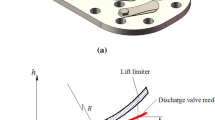Abstract
The suction valve of a linear compressor is a reed valve and the discharge valve is a circular plate valve. The reed valve moves in three dimensions while the discharge valve translates in one dimension. Thus, the reed valve needs a FSI model but the discharge valve can use a rigid body model. In this study, both the FSI model and the rigid body model were applied to the suction valve to find out if they are appropriate for the cycle analysis of the linear compressor. The effects of the valve dynamics on the cooling capacity, the compression power, and EER were investigated for each valve model. The results show that both models are in good agreement with the experiments although the FSI model is more appropriate for the prediction of the valve lift or closing time. However, the computation time of the FSI model is approximately 10 times greater than that of the rigid body model. Therefore, if the structural analysis of the valve is not necessary, the rigid body model can be effectively used to predict the cycle performance such as EER or compression work.
Similar content being viewed by others
References
K. Liang, R. Stone, M. Dadd and P. Bailey, The effect of clearance control on the performance of and oil-free linear refrigeration compressor and a comparison between using a bleed flow and a DC bias, International Journal of Refrigeration, 69 (2016) 407–417.
K. Liang, R. Stone, W. Hancock, M. Dadd and P. Bailey, Comparison between a crank-drive reciprocating compressor and a novel oil-free linear compressor, International Journal of Refrigeration, 45 (2014) 25–34.
C. R. Bradshaw, E. A. Groll and S. V. Garimella, A comprehensive model of a miniature-scale linear compressor for electronics cooling, International Journal of Refrigeration, 34 (2011) 63–74.
H. Lee, S. H. Ki, S. S. Jung and W. H. Rhee, The innovative green technology for refrigerators development of innovative linear compressor, Proceedings International Compressor Engineering Conference, Purdue University, 1419 (2008) 1–6.
H. Lee, S. S. Jeong, C. W. Lee and H. K. Lee, Linear compressor for air-conditioner, International Compressor Engineering Conference, C047 (2004) 1–7.
Y. Wang, C. Xue, J. Feng and X. Peng, Experimental investigation on valve impact velocity and inclining motion of a reciprocating compressor, Applied Thermal Engineering, 61 (2013) 1701–1715.
A. Bhakta, S. Dhar, V. Bahadur, S. Angadi and S. Dey, A valve design methodology for improved reciprocating compressor performance, International Compressor Engineering Conference, 1252 (2012) 1–8.
J. H. Kim, S. Y. Wang, S. W. Park, K. O. Ryu and J. P. La, Valve dynamic analysis of a hermetic reciprocating compressor, International Compressor Engineering Conference, C107 (2006) 1–10.
E. Silva, C. J. Dechamps and E. A. Fancello, A procedure to optimize reed type valves considering efficiency and bending fatigue, International Compressor Engineering Conference, 1345 (2012) 1–9.
F. H. Shiomi and C. K. Takemori, Modeling strategies for the dynamics of reed type valves, 13th Brazilian Congress of Thermal Sciences and Engineering, Proceedings of ENCIT 2010 (2010).
K. H. Suh, D. Y. Heo and H. S. Kim, CAE/CAD application for linear compressor, International Compressor Engineering Conference, C032 (2006) 1–8.
Y. S. Choi, J. J. Lee, W. N. Jeong and I. G. Kim, Dynamic behavior of valve system in linear compressor based fluidstructure interaction, Journal of Mechanical Science and Technology, 24 (7) 1371–1377.
National Institute of Standards and Technology, Thermodynamic and transport properties of refrigerants and refrigerant mixtures database V 7.0 (2013).
H. T. Sanergy, Material data sheet, Sandvik Materials Technology (2009).
Ansys Fluent V15, Ansys Inc., User’s guide V15 (2013).
CATIA. V5. R21, Dassault System (2014).
Ansys workbench V15, Ansys Inc., User’s guide V15 (2013).
J. K. Kim, C. G. Roh, H. Kim and J. H. Jeong, An experimental and numerical study on an inherent capacity modulated linear compressor for home refrigerators, International Journal of Refrigeration, 34 (2011) 1415–1423.
Author information
Authors and Affiliations
Corresponding author
Additional information
Recommended by Associate Editor Chang Yong Park
Sang Jun Park graduated from Kongju National University with a major in Mechanical and Automotive Engineering in 2012. Now he is a graduate student in Ph.D. program at the Department of Mechanical Engineering of Kongju National University.
Young Lim Lee graduated from Hanyang University with a major in Mechanical Engineering in 1986. He got a Ph.D. at University of Texas at Austin in 1995. He is currently interested in the research topics of high efficiency linear compressor as well as electronics cooling, vacuum glazing and heat pumps.
Rights and permissions
About this article
Cite this article
Park, S.J., Hwang, I.S., Oh, W.S. et al. A study on cycle performance variation of a linear compressor considering valve behavior. J Mech Sci Technol 31, 4481–4488 (2017). https://doi.org/10.1007/s12206-017-0848-z
Received:
Revised:
Accepted:
Published:
Issue Date:
DOI: https://doi.org/10.1007/s12206-017-0848-z




